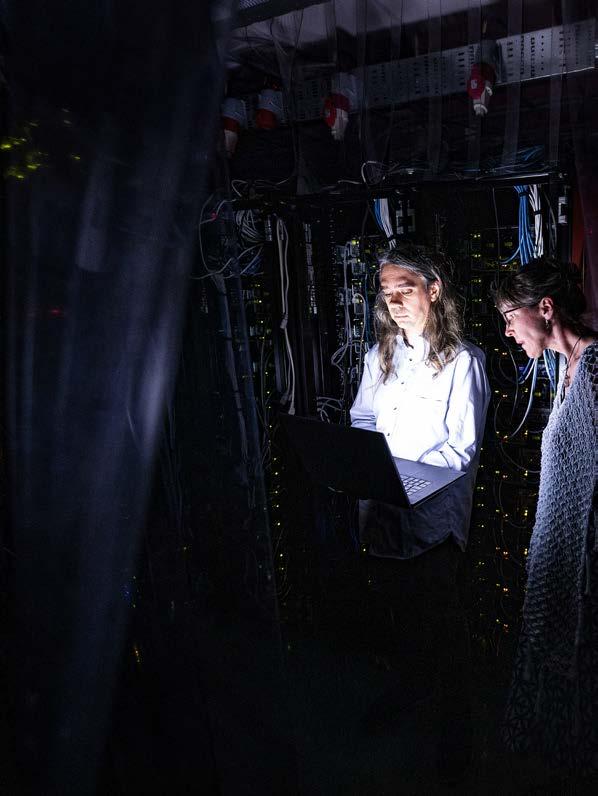
6 minute read
Supercomputers in the service of the scientific community
Super computers in the service of the scientific community

As the production of research data increases, demands on national computer centres are escalating. New user groups are streaming to the Uppsala Multidisciplinary Centre for Advanced
Computational Science (UPPMAX) from fields such as political science, economics and, not least, pharmaceutical science.

text ANNELI BJÖRKMAN photo MIKAEL WALLERSTEDT
T
THE NOISE STRIKES you as soon as you enter the computer centre in the basement of the Ångström Laboratory. That and the cold. This is because of fans running around the clock; otherwise, there would be a risk of computers and networks overheating and research data being lost.
Servers stand in rows in the 100-squaremetre space, all linked in networks. Inside the supercomputers’ processors, 20,000 computational cores are working to perform advanced calculations for over 1,200 users at Uppsala University and other Swedish higher education institutions.
The storage system containing all of the research data in UPPMAX has a capacity in excess of 23,000 terabytes and consumes an average of 350 kilowatts. UPPMAX is one of six national centres within the Swedish National Infrastructure for Computing (SNIC), the combined energy consumption of which is equivalent to heating 1,000 Swedish houses using electricity.
In the computer centre the fans are running around the clock; otherwise, there would be a risk of computers and networks overheating and research data being lost.

THE ELECTRICITY CONSUMPTION at UPPMAX has remained stable over the past four years, despite a quadrupling of computing and storage capacity. This is due to the more efficient and larger systems installed to meet growing demand for data processing.
“Research needs have become more extensive and almost all research now requires computing resources of a completely different order than have traditionally been available,” says Ingela Nyström, chair of the board of SNIC, who adds that competition for capacity to process research data at computer centres will only increase. This is particularly true as these centres provide researchers with several levels of user support.
“Given the current crisis, we have ensured that research into COVID-19 has slight priority to our resources,” says Hans Karlsson, Director of the Swedish National Infrastructure for Computing (SNIC).
If that wasn’t enough, new user groups are constantly being added, many of whom are looking for sufficient resources to be able to quickly obtain new answers so that they can move on with their research. In this regard, as Carl Nettelblad, technical coordinator at UPPMAX, says:
“We are already finding it challenging to support these two user groups – those conducting very large-scale computations and those with less extensive requirements but who demand rapid, interactive flows.”
PREVIOUSLY, ASSIGNMENTS have primarily come from researchers in the fields of physics, chemistry and fluid mechanics; however, data analysis is increasingly in demand in digital humanities such as political science, economics and philosophy. In addition, according to Hans Karlsson, the explosion in demand for computation in life sciences has pushed the issue of long-term funding to the top of the agenda.
“During the coming year, a government inquiry will be looking at the organisation, governance and financing of national research infrastructure. We hope that this will give due consideration to the new, broader need for data processing. This is a matter of modernising computers, increasing storage capacity and providing training and support to both new and existing users.”

The storage system containing all of the research data in UPPMAX has a capacity in excess of 23,000 terabytes and consumes an average of 350 kilowatts.
UPPMAX ALSO HOSTS SNIC-SENS, a project that provides secure storage and processing of sensitive personal data (such as human genomic data) to the research community. In conjunction with the pandemic outbreak in spring 2020, UPPMAX contributed unutilised computational capacity to the international research project Folding@home. The computer centre’s supercomputers analysed proteins on the cell surface of the COVID-19 virus. Simulations were run in the hope of identifying possible candidate drugs for the treatment of infected patients.
In another project, involving Lynn Kamerlin’s Uppsala University research group among others, mathematical models were developed to show how COVID-19 might spread in the Swedish population depending on the implementation of various types of measures.
“UPPMAX WAS ONE of four SNIC computer centres used for computations involving over 10 million people,” says Elisabeth Larsson, Director of UPPMAX, who adds:
“Our high-performance computing systems can play a crucial role in understanding COVID-19 and we will continue
From the left: Ingela Nyström, Hans Karlsson, Lars-Owe Ivarsson, Elisabeth Larsson and Carl Nettelblad.

to ensure resources for projects related to the virus.”
Operationally, UPPMAX has coped well with this spring’s challenges without any serious disruption to systems.
“This is pleasing given just how many researchers are affected by the smooth running of our facility,” says Larsson.
Voluntary measures were very effective
Voluntary measures to reduce the spread of infection have been crucial in limiting the number of cases and deaths from COVID-19 in Sweden. These are the findings of a study in which researchers have used a model loaded with extensive information about Sweden’s population.
Different countries have used varying strategies to limit the spread of COVID-19, and in international comparisons Sweden has stood out as a country with relatively moderate restrictions. Since the country’s strategy to limit the spread of the infection is largely based on recommendations from authorities, many people expected a large number of deaths in Sweden. But this worst-case scenario has not come to pass. Researchers at Uppsala University have used a computer model to explain why.
“When we initially modelled the effect of the restrictions from the Swedish Public Health Agency, we expected many more deaths and hospitalisations than actually occurred. We can conclude that many people in Sweden have taken voluntary measures to limit the spread of the infection. These individual efforts have had a large effect and fundamentally changed the course of the pandemic in Sweden,” says Peter Kasson, Senior Lecturer at the Department of Cell and Molecular Biology at Uppsala University.
Together with Lynn Kamerlin, Professor at the Department of Chemistry, he has used a computer model that takes every individual in Sweden into account to simulate how the disease spreads from person to person depending on individual social behaviour. This model predicted that the mandatory restrictions from the Public Health Agency alone would have little effect on the spread of the infection and lead to an overwhelmed health system. However, this did not turn out to be the case for Sweden.
When the model was adjusted to consider voluntary measures, the forecast aligned better with reality. To create a more accurate model that can explain a course of events is valuable even after the fact. It can be a tool in comparisons, analyses and reflections on what worked well and what could have been done differently.
“We see that significant individual measures can work almost as well as an extensive shutdown of society, if a large percentage of the population adopts such measures. Studies of the movement patterns of Swedes in the last few months indicate that at least a third of the population reduced its exposure to the virus at workplaces and in other social situations. This has had a large impact on the course of events,” says Kamerlin.










